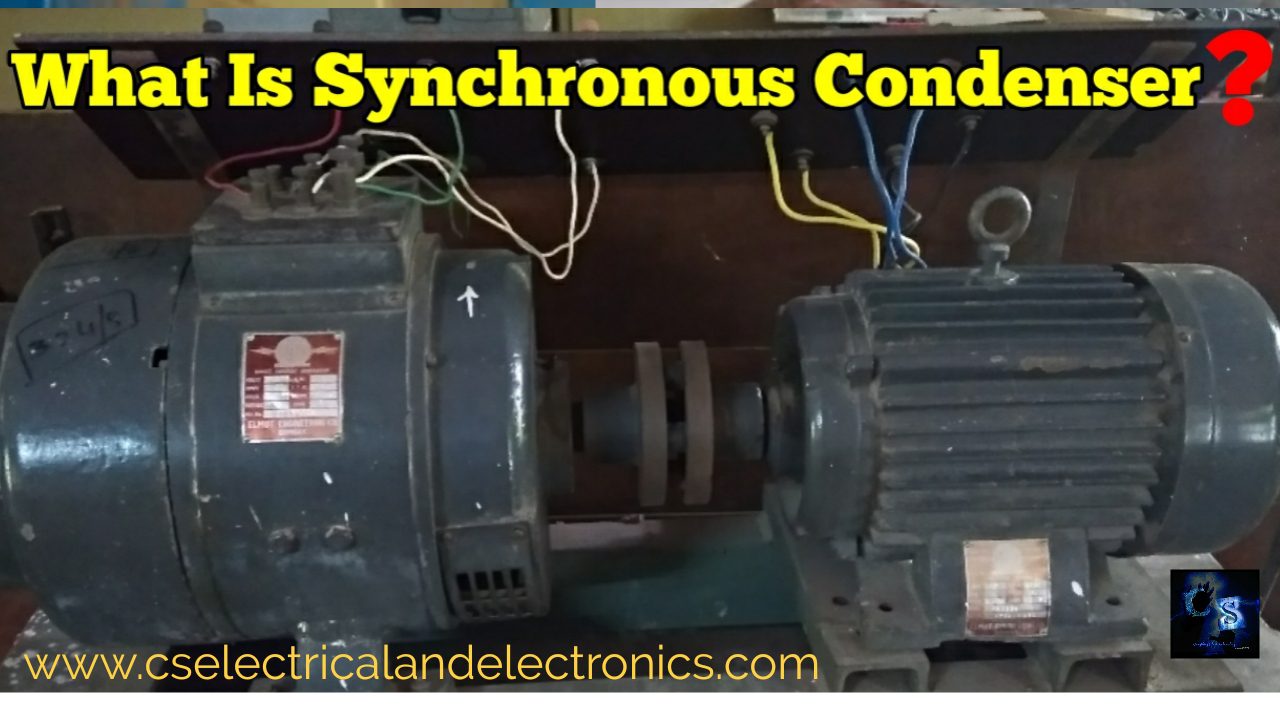What Is Synchronous Condenser, Advantages, Applications, Conclusion
Hello guys, welcome back to my blog. In this article, I will discuss What Is Synchronous Condenser, Advantages, Applications, Conclusion, advantages of synchronous condenser, applications of synchronous condenser, etc.
If you require an article on any other topics then comment us below in the comment box. You can also catch me @ Instagram – Chetan Shidling.
Also read – Electrical Machines Questions And Answers.
What Is Synchronous Condenser
Introduction: The synchronous condenser is also called a synchronous capacitor because of its operation is the same working of capacitor
Present scope or objectives
It is mainly used nowadays in power factor correction to improve the power factor from lagging to leading (by using synchronous condenser motor).
Operation of sychronous condenser
If Synchronous motor is on no load and overexcited (Eb > V) then the current drawn by it leads the voltage by nearly 90. This characteristic is similar to a normal capacitor which always takes leading of current. Hence over-excited synchronous motor operating on no-load condition is called Synchronous Condenser or Synchronous Capacitor.
This is the property due to which synchronous motor is used as a phase advancer or as a power factor Improvement device. we can use an overexcited synchronous motor to improve the poor power factor of a power system. The main advantage of using the synchronous motor is that the improvement of the power factor is smooth. When a synchronous motor operates with over-excitation, it draws leading current from the supply. We use this property of a synchronous motor for the purpose. Here, in a three-phase system, we attach one three-phase synchronous motor and run it at no load.
In the power system, due to a reactive load, the system draws a current (IL) from the source at a lagging angle (θL) in honor of voltage. Now the motor draws a current (IM) from the equivalent source at a leading angle (θM). Now the entire current drawn from the supply is the vector sum of the load current (IL) and motor current (IM). The resultant current (I) drawn from the source has an angle θ with respect to voltage. The angle θ is less than angle θL. Hence the power factor of the system cosθ is now higher than the power factor cosθL of the system before we attach the synchronous condenser to the system.
Then a static capacitor bank, the synchronous condenser is the more excellent method of improving the power factor, but power factor improvement by synchronous condenser below 500 kVAR is not efficient than that by a static capacitor bank. For some industries, we use synchronous condensers for the purpose, but for relatively lower rated systems we usually use capacitor banks.
The benefits of a synchronous condenser are that we can control the power factor of the system smoothly without stepping as per demand. In the cause of a static capacitor bank, this fine adjustments of power factor cannot be possible rather a capacitor bank improves the power factor stepwise.
Although, the synchronous condenser system has some drawbacks. The system is not silent as the synchronous motor has to rotate continuously.
Synchronous Condensor is also known as Synchronous Phase Modifier or Synchronous Compensator. A synchronous condenser or a synchronous compensator is a synchronous motor running without a fixed load. It can generate or consume reactive volt-ampere (VAr) by varying the excitation of its field winding. It can be arranged to take a leading current with over-excitation of its field winding.
In such a situation it gives inductive or absorbs capacitive Volt-ampere reactive. If it is under the excited condition, it draws the lagging current and, consequently, supplies capacitive or absorbs inductive volt-ampere reactive. Therefore, a current drawn by a synchronous capacitor or condenser can be modified from lagging to leading smoothly by varying its excitation.
If the motor power factor is unity, the DC excitation is said to be normal. Over-excitation makes the motor to operate at a leading power factor. Under excitation makes it operate at a lagging power factor. When the motor is run at no load with over-excitation, it takes a current that leads the voltage by approximately 90 degrees.
Thus, it acts as a capacitor, and under such operating conditions, the synchronous motor is called a synchronous capacitor.
Since a synchronous condenser acts like a variable inductor or a variable capacitor, it is used in power transmission systems to regulate line voltage.
Conclusion: Synchronous motor which is overexcited under no-load conditions than the current drawn by the motor is leading with respect to a voltage by nearly 90°.
I hope this article may help you all a lot. Thank you for reading.
Also read:
- Top 100 Vector CANoe Interview Questions With Answers
- Major Brands And Their Microcontrollers In The Automotive Industry
- 8 Reasons Why EVs Can’t Fully Replace ICE Vehicles in India
- Basic MATLAB Simulink Blocks Engineers Must Know
- Top Software Compliance Standards Across Industries

